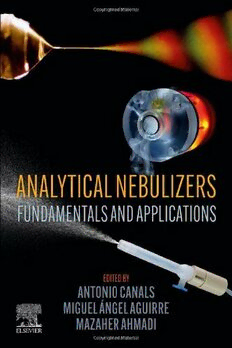
Analytical Nebulizers: Fundamentals and Applications PDF
Preview Analytical Nebulizers: Fundamentals and Applications
ANALYTICAL NEBULIZERS ANALYTICAL NEBULIZERS Fundamentals and Applications Edited by A C NTONIO ANALS DepartmentofAnalyticalChemistryandFoodScienceandUniversityInstituteofMaterials, FacultyofScience,UniversityofAlicante,Alicante,Spain ´ M A A IGUEL NGEL GUIRRE DepartmentofAnalyticalChemistryandFoodScienceandUniversityInstituteofMaterials, FacultyofScience,UniversityofAlicante,Alicante,Spain M A AZAHER HMADI DepartmentofAnalyticalChemistry,FacultyofChemistry,Bu-AliSinaUniversity, Hamedan,Iran Elsevier Radarweg29,POBox211,1000AEAmsterdam,Netherlands TheBoulevard,LangfordLane,Kidlington,OxfordOX51GB,UnitedKingdom 50HampshireStreet,5thFloor,Cambridge,MA02139,UnitedStates Copyright©2023ElsevierInc.Allrightsreserved. Nopartofthispublicationmaybereproducedortransmittedinanyformorbyanymeans, electronicormechanical,includingphotocopying,recording,oranyinformationstorageand retrievalsystem,withoutpermissioninwritingfromthepublisher.Detailsonhowtoseek permission,furtherinformationaboutthePublisher’spermissionspoliciesandourarrangements withorganizationssuchastheCopyrightClearanceCenterandtheCopyrightLicensingAgency, canbefoundatourwebsite:www.elsevier.com/permissions. Thisbookandtheindividualcontributionscontainedinitareprotectedundercopyrightbythe Publisher(otherthanasmaybenotedherein). Notices Knowledgeandbestpracticeinthisfieldareconstantlychanging.Asnewresearchandexperience broadenourunderstanding,changesinresearchmethods,professionalpractices,ormedical treatmentmaybecomenecessary. Practitionersandresearchersmustalwaysrelyontheirownexperienceandknowledgein evaluatingandusinganyinformation,methods,compounds,orexperimentsdescribedherein. Inusingsuchinformationormethodstheyshouldbemindfuloftheirownsafetyandthesafety ofothers,includingpartiesforwhomtheyhaveaprofessionalresponsibility. Tothefullestextentofthelaw,neitherthePublishernortheauthors,contributors,oreditors,assume anyliabilityforanyinjuryand/ordamagetopersonsorpropertyasamatterofproductsliability, negligenceorotherwise,orfromanyuseoroperationofanymethods,products,instructions,or ideascontainedinthematerialherein. ISBN:978-0-323-91181-8 ForinformationonallElsevierpublications visitourwebsiteathttps://www.elsevier.com/books-and-journals Publisher:SusanDennis AcquisitionsEditor:CharlotteRowley EditorialProjectManager:CatherineCostello ProductionProjectManager:SuryaNarayananJayachandran CoverDesigner:MatthewLimbert TypesetbySTRAIVE,India Contributors Abbas Afkhami Department of Analytical Chemistry, Faculty of Chemistry, Bu-AliSinaUniversity;D-8InternationalUniversity,Hamedan,Iran Miguel A´ngel Aguirre Department of Analytical Chemistry and Food Science andUniversityInstituteofMaterials,FacultyofScience,UniversityofAlicante, Alicante,Spain Mazaher Ahmadi Department of Analytical Chemistry, Faculty of Chemistry, Bu-AliSinaUniversity,Hamedan;AutophagyResearchCenter,ShirazUniver- sityofMedicalSciences,Shiraz,Iran Roberto A´lvarez-Ferna´ndez Garcı´a Department of Physical and Analytical Chemistry, Faculty of Chemistry and Health Research Institute of Asturias (ISPA),UniversityofOviedo,Oviedo,Spain Zahra Amouzegar Department of Analytical Chemistry, Faculty ofChemistry, Bu-AliSinaUniversity,Hamedan,Iran Sepideh Asadi Department of Analytical Chemistry, Faculty of Chemistry, Bu-AliSinaUniversity,Hamedan,Iran Sonia Bahrani Nanotechnology Department, Borjobaru Fars Company, Fars ScienceandTechnologyPark;HealthPolicyResearchCenter,HealthInstitute, ShirazUniversityofMedicalSciences,Shiraz,Iran Jo€rg Bettmer Department of Physical and Analytical Chemistry, Faculty of Chemistry and Health Research Institute of Asturias (ISPA), University of Oviedo,Oviedo,Spain Antonio Canals Department of Analytical Chemistry and Food Science and University Institute of Materials, Faculty of Science, University of Alicante, Alicante,Spain Mario Corte-Rodrı´guez Department of Physical and Analytical Chemistry, Faculty of Chemistry and Health Research Institute of Asturias (ISPA), UniversityofOviedo,Oviedo,Spain Marta Costas-Rodriguez Department of Green Chemistry and Technology, GhentUniversity;DepartmentofChemistry,GhentUniversity,CampusSterre, Ghent,Belgium Jefferson Santos de Gois Department of Analytical Chemistry, Rio de Janeiro StateUniversity,RiodeJaneiro,Brazil AliFathi DepartmentofAnalyticalChemistry,FacultyofChemistry,Bu-AliSina University,Hamedan,Iran ix x Contributors Tadesse Haile Fereja State Key Laboratory of Electroanalytical Chemistry, Changchun Institute of Applied Chemistry, Chinese Academy of Sciences, Changchun,Jilin,People’sRepublicofChina;DepartmentofPharmacy,College ofMedicineandHealthSciences,AmboUniversity,Ambo,Ethiopia AlfonsoM.Gan˜a´n-Calvo DepartamentodeIngenier´ıaAeroespacialyMeca´nica deFluidos,ETSI;LaboratoryofEngineeringforEnergyandEnvironmentalSus- tainability,UniversidaddeSevilla,Sevilla,Spain Paula Garcı´a-Cancela Department of Physical and Analytical Chemistry, FacultyofChemistryandHealthResearchInstituteofAsturias(ISPA),Univer- sityofOviedo,Oviedo,Spain Deyana Georgieva Department of Analytical Chemistry and Computer Chemistry,UniversityofPlovdiv“PaisiiHilendarski”,Plovdiv,Bulgaria Krzysztof Jankowski Faculty of Chemistry, Department of Analytical Chemistry,WarsawUniversityofTechnology,Warsaw,Poland Jos(cid:2)eM.Lo´pez-Herrera DepartamentodeIngenier´ıaAeroespacialyMeca´nicade Fluidos,ETSI,UniversidaddeSevilla,Sevilla,Spain Tayyebeh Madrakian Department of Analytical Chemistry, Faculty of Chemistry,Bu-AliSinaUniversity,Hamedan;AutophagyResearchCenter,Shi- razUniversityofMedicalSciences,Shiraz,Iran Luis B. Modesto-Lo´pez Departamento de Ingenier´ıa Aeroespacial y Meca´nica deFluidos,ETSI,UniversidaddeSevilla,Sevilla,Spain FaribaMollarasouli DepartmentofChemistry,YasoujUniversity,Yasouj,Iran Mar´ıaMontes-Bayo´n DepartmentofPhysicalandAnalyticalChemistry,Faculty of Chemistry and Health Research Institute of Asturias (ISPA), University of Oviedo,Oviedo,Spain Mariusz S´lachcin(cid:2)ski Poznan University of Technology, Faculty of Chemical Technology,Poznan,Poland Guobao Xu State Key Laboratory of Electroanalytical Chemistry, Changchun InstituteofAppliedChemistry,ChineseAcademyofSciences,Changchun,Jilin; UniversityofScienceandTechnologyofChina,Hefei,Anhui,People’sRepublic ofChina Acknowledgments Weacknowledgeallthepeoplewhohelpedwiththecoverimagesfor this book: (cid:129) Electrospray in Taylor cone-jetmode (courtesyof AlfonsoM. Gan˜a´n- Calvo) (cid:129) Ultrasonic nebulizer (courtesyof Mariusz S´lachcin(cid:1)ski) (cid:129) MultiNeb by Ingeniatrics Tecnolog´ıas S.L., Universidadde Alicante, Universidad de Sevilla (courtesy of Alfonso M.Gan˜a´n-Calvo) xi C H A P T E R 1 An introduction to nebulizers Mazaher Ahmadia, Miguel A´ ngel Aguirreb, and Antonio Canalsb aDepartment ofAnalytical Chemistry,Facultyof Chemistry,Bu-Ali Sina University,Hamedan, Iran, bDepartment ofAnalytical Chemistry and Food ScienceandUniversityInstituteofMaterials,FacultyofScience,Universityof Alicante,Alicante, Spain 1.1 Analytical nebulizers In analytical plasma-based techniques, sample introduction is one of the most important steps. There are a variety of sample introduction options available, including nebulizers, electrothermal vaporization, chemical vapor generation, and laser ablation devices. Because of their readiness for use, ease of coupling with autosamplers, and the ability to provide accurate results when used appropriately, nebulizers connected toaspraychamberarethemostextensivelyutilizedamongothersample introduction systems. Whenlookingfornebulizersontheinternet,thereadermustbecareful becausetheaerosolgenerationcanbereferredtoasairblastatomizationin themedicalliterature,andthenebulizerscanbereferredtoasatomizers, soproperterminologymustbeusedwhenthesubjectisforanalyticalpur- poses,wherethetermatomizationisawell-knownphenomenoninatomic spectrometry(i.e.,theconversionofvolatilizedanalyteintofreeatoms).In analyticalchemistry,thewordnebulizerreferstoadevicethatmaytrans- formthebulkliquidintoanaerosol.Theaerosolisthemostpopularway topresentthesampletothedetector.Particularly,inplasma-basedtech- niques, the primary purpose of breaking down the liquid sample into small droplets is to increase the surface area of the sample so that both sampletransportedisincreasedandtheprocessesofdesolvation,vapor- ization,atomization,excitation,and/orionizationcanrunsmoothlyinto theplasma. 3 AnalyticalNebulizers Copyright©2023ElsevierInc.Allrightsreserved. https://doi.org/10.1016/B978-0-323-91181-8.00001-1 4 1. Anintroductiontonebulizers Alargenumberofcommercialanalyticaltechniquesarebasedonneb- ulizersforsampleintroductionsystems,necessitatingabettergraspofthe fundamental ideas and applications of this critical phenomenon. How- ever, despite its ease of implementation, the nebulizer is considered as ablackbox,anditmaynotbetouchedforlongperiodsoftimeforcleaning orreplacement.Asaresult,inmostcircumstances,theselectionanduseof acorrectnebulizerforaspecificapplicationarecrucial,anditiscriticalto comprehend all ideas and challenges linked to nebulizer selection. The right nebulizer may improve sensitivity, precision, minimize interfer- ences, shorten washout times, eliminate the need for preceding sample preparation stages, and even allow for the analysis of micro-quantities ofmaterials without theneed for special equipment. 1.2 Types of analytical nebulizers Aerosol generation requires the contribution of a certain amount of energy to the liquid mass in order to overcome the cohesive forces of the liquid (e.g., surface tension and viscosity), dividing it into droplets. Depending on the energy source, the most common nebulizers used in chemical analysis can be classified as (i) pneumatic nebulizer, (ii) hydraulic nebulizer, (iii) ultrasonic nebulizer, and (iv) electrostatic nebulizer.Additionally,pneumaticnebulizerscanbecategorizedaseither concentric or nonconcentric nebulizers (Fig. 1.1). Other criteria such as FIG.1.1 Classificationofanalyticalnebulizersbasedontheenergysource.Nopermission required. 1. Fundamentals
